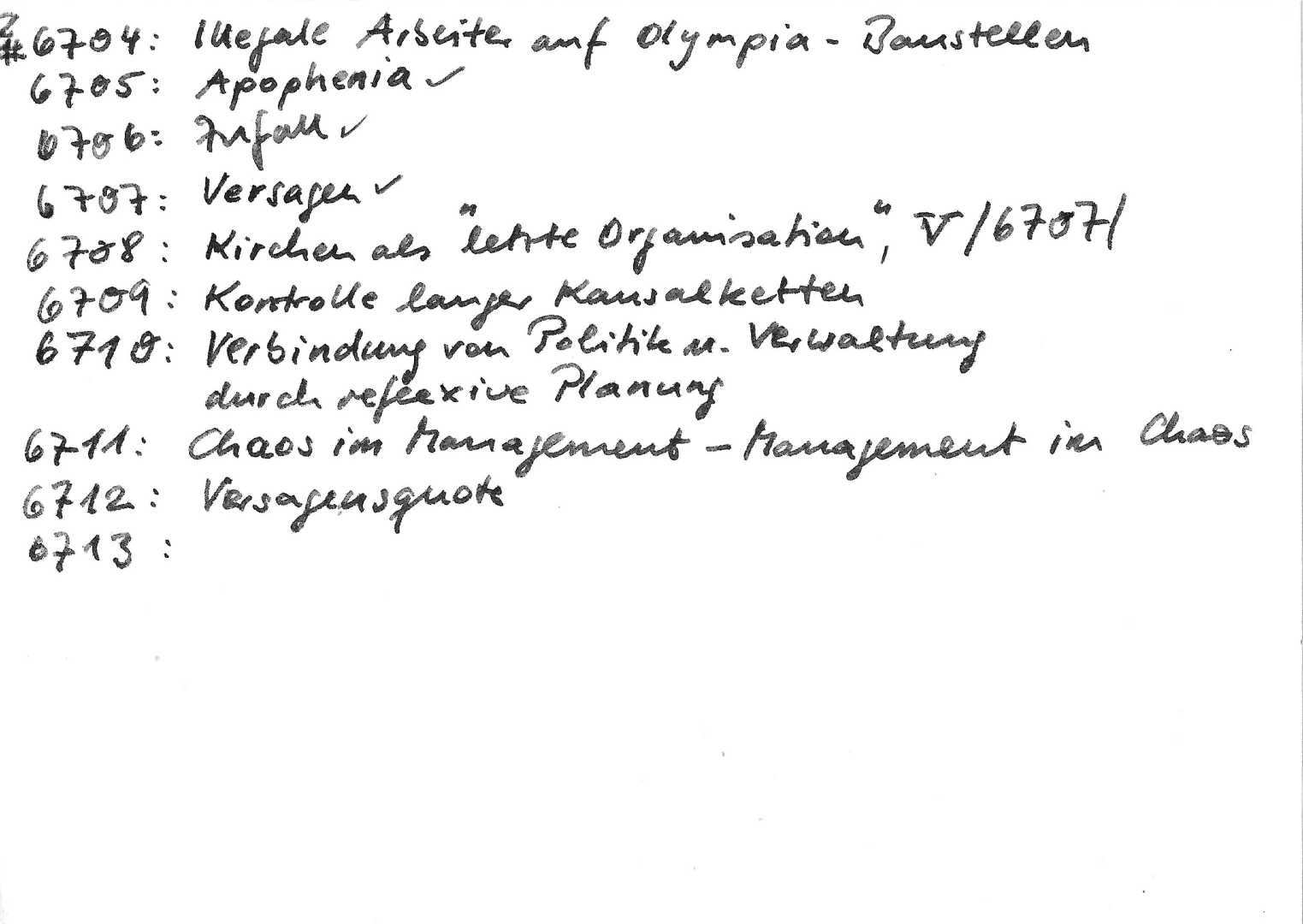When working analog/digital with a Niklas Luhmann-style Zettelkasten, it is important to be able to draw the next card (Zettel) number.
The following illustration shows such a list of numbers already assigned and the next available number.

Z#…
[…]
7014: Virtual Token Descriptor
7013: JExample
[…]
6992: Donald Trump’s Election
=> 6993
[…]
6974: Bifurkation
6973: Handlungsausführungsfehler
6972: Fehler
6971: Fehlmarkierungen
6970: Marked and unmarked terms
6969: Pfad
[…]
6883: Gabriel RP (2023): Notes on "Notes on the Synthesis of Form"
[…]
6874: IV. Die Unterscheidung von System und Umwelt (within Chapter 1 of GdG)
6873: Ecosocieties
6872: Netzwerk
6871: Lebende Systeme
6870: Codierung und Programmierung
6869: Kreuzen zwischen den Codewerten, Prozeß der Spezifikation von Annahmezumutungen
6868: Kreuzen
6867: Codierung
6866: Globalisierung
6865: Kausalitätskette
6864: Lehrbuch der Soziologie
6861: Berufserfahrung
6859: Konditionen
6858: Vocabulary
6857: Technischer Redakteur
6856: Selling Points
6855: getActivatedEntryNumber
6854: Sauerstoff
6853: Bruno Latour
6852: endlos
6850: Gedanken
6849: Gegenbeobachtung
6848: Magie
6847: Technologie
6846: Personal Computer
6845: Kindheit
6844: Variabilität
6843: Symbol
6842: Moldable Data Wrapper
6841: Verbindung
6840: Längen-Primitiv
6839: Realtalk
6838: ObVlisp
6837: Deep Work
6835: Medien der Weltbeziehung
6834: Sitemap
6833: Analyse von WebAssembly-Binärprogrammen
6832: Blatt
6831: Zeichenspiele
6828: Wikipedia and the Representation of Reality
6827: Students' Perceptions of Wiki-based Collaborative Writing …
6826: Héctor Ramón
6825: A Feasible User Story Tool for Agile Software Development?
6824: Four Vignettes of Learning: Wiki Wiki Web or What Went Wrong
6823: Wiki Wiki Web
6821: Concurrency
6820: Question
6819: Q
6818: Structure
6817: Event
6816: Causality
6815: Talk
6814: Funktion => F/6813/de
6813: Function
6812: Polydox
6811: Commercial Environment
6810: Thwarting Systems
6809: Schedule
6808: Communication Deficiency
6807: Beobachter
6806: Absence/Presence
6805: Loss of Tempo Signal
6804: Tempo Interruptions
6803: Tempo
6802: Episode
6800: Grep
6799: Hauptsache Arbeit! Aber nur im wirklichen Leben?
6798: Command and Control
6797: Code
6796: Eigentum See Property/Money (Eigentum/Geld).
6795: Zwischennutzung
6794: Wiederholung
6793: Problem
6789: Data-Driven Skepticism
6788: Intention
6787: Beschreibung
6786: Task Oriented Programming (or shortly TOP)
6785: Yesod
6784: Y
6783: Signature
6781: Haskell
6780: Dan (within Rendanheyi, 6722)
6779: match
6778: Pair
6777: Customer-Supplier Pairs
6776: Binary Computing
6775: Dependency Graph
6774: Coevolution
6773: Running DMX behind an Apache Reverse Proxy page ![]()
6772: Innovation, revolutionäre von 1789 – Verbindung von Nation und Republik
6771: AssertJ Swing
6770: How We Fragment the World
6769: oscillate
6768: Fact Dimension
6767: Dimensionality
6766: Social Dimension
6765: Wiki's Third Dimension
6764: Gegenbegriff
6763: Heart Rate Variability
6762: Real Time
6760: => Tangled Layered Tempos, 6746
6759: Rhythm and Tempo
6758: Temporal Dimension
6757: Steuerung
6756: Handwritten Notes Provide Access to Recorded Conversations
6755: Handwritten Notes
6754: Community Engagement
6752: Heart Center
6751: Gleichgewicht
6750: Equilibrium
6749: Communication Ethics Research
6747: Verschlungene, vielschichtige Tempi
6746: Tangled Layered Tempos
6745: Form der Kontrolle
6744: The Ethical Imperative
6743: Intervention
6742: Heuchelei
6741: Decision Optimization
6740: Genozid/Lüge
6739: Safe Space
6738: die Arbeit der Abteilung Polizeiwissenschaften
N/6714/1/R
6737: Upgrades from Debian 10 (buster)
6736: Consequentialism
6735: Teleological Ethics (wiki) See: Motive Inference
[…]
Numerus Currens (lat. „Fortlaufende Nummer“) oder mechanische Aufstellung bezeichnet eine Methode der Magazinierung speziell in Bibliotheksmagazinen und Archiven, bei der die Medien in der Reihenfolge ihres Eingangs fortlaufend nummeriert und angeordnet werden. In der Regel wird dabei nach Format getrennt. wikipedia ![]()